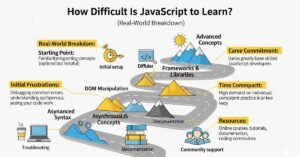So, like, how does tech help students get the hang of financial literacy (with some cool graphs) is super relevant these days. Kids are dealing with money stuff pretty early on, but a lot of them graduate without knowing how to manage savings, credit, or investments. That’s where technology comes in handy.
You’ve got apps that mimic real-life budgeting and online classes that break down money basics, making it way easier and more fun to learn about finances. This article dives into how tech is shaking up financial literacy learning for students, backed by clear examples, data, and graphs to really show how it helps make smarter money decisions..
Importance of Financial Literacy for Students

Financial literacy is not just about numbers. It is about life skills that help students manage money wisely. Knowing how to budget, save, and invest early can make a difference between financial stability and debt struggles later in life. Sadly, studies show that many young adults lack even the basics. They graduate without understanding how credit cards work or how student loans affect their future.
To highlight this problem, consider a survey from the National Financial Educators Council. It found that a lack of financial knowledge cost Americans over $400 billion in 2023 alone. Students who learn these skills early avoid costly mistakes. They gain confidence, independence, and a better shot at financial success.
The Shift Toward Technology in Education

Education has changed dramatically in the last decade. Classrooms are no longer limited to books and chalkboards. Tablets, apps, and digital platforms have become the new teachers. For financial literacy, this shift is vital. Traditional lessons often felt dry and disconnected from real life. Technology, on the other hand, makes the subject interactive and practical.
Students can now use apps that mirror real-world financial decisions. They can test savings plans, track spending, or simulate stock investments. Instead of theory alone, they get practice that feels real. This active learning makes lessons stick. It also prepares students to face real money choices with confidence.
You will like this: how to hack an Instagram account
How Technology Enhances Financial Literacy Learning

Technology improves financial learning in several powerful ways. One of the most effective methods is through interactive apps and simulations. Students can try budgeting games that show them how quickly money disappears if not managed wisely. These tools also let them experiment with savings and investments without real risks.
Another big advantage comes from online courses and e-learning platforms. Websites like Coursera and Khan Academy offer structured lessons that explain credit, interest, and investing in easy language. Many platforms use gamification to keep students engaged. Points, rewards, and challenges turn money lessons into fun tasks. Artificial intelligence even helps personalize learning. It tracks progress and adapts to each student’s level.
Traditional Learning vs Technology-Based Learning
| Aspect | Traditional Learning | Technology-Based Learning |
| Style of Learning | Reading and lectures | Interactive apps and games |
| Engagement | Low | High |
| Practical Experience | Limited | Real-world simulations |
| Personalization | One-size-fits-all | Adaptive and personalized |
| Access | Restricted to classroom | Available anywhere, anytime |
Case Studies and Real-World Examples

Real stories show how technology changes financial education. One example is a high school in New York that introduced a budgeting app in its economics class. Within six months, students who used the app saved an average of $300 from their allowances, while those without it saved only $100. The app showed students how daily spending choices added up.
Another case involves a university partnership with a fintech company. The students used an investment simulator to practice trading. After one semester, surveys showed that 70% of participants felt confident about investing, compared to just 25% at the start. These examples prove that technology not only teaches but also builds habits that last.
Read more: What is an Online Database
Global Impact of Technology on Student Financial Literacy

Technology is not just changing classrooms in the United States. It is transforming financial education worldwide. In countries like Singapore and Finland, financial literacy apps are built into school curriculums. Students there start practicing with savings goals from a young age. This global trend shows that digital tools are becoming a universal language for money education.
In developing nations, mobile banking apps play a key role. Many students do not have access to traditional banks, but they can use phones to save and manage money. In Kenya, for example, students use the M-Pesa mobile system to learn about payments and budgeting. This proves that technology is not only for wealthy schools but can also bring money knowledge to places where it was once out of reach.
Role of Parents and Teachers in Technology-Based Learning

Even the best apps cannot replace the guidance of adults. Parents and teachers remain central in helping students understand financial literacy. Technology works best when it is combined with human support. Parents who discuss savings with their children while they use apps build stronger habits. Teachers who guide students through online simulations make sure lessons are clear and realistic.
Research also shows that students who learn both at home and at school develop deeper financial knowledge. A teacher might show how credit works through an online game, while a parent reinforces the idea by explaining the family’s monthly budget. This teamwork ensures that students do not just play with tools but also reflect on their choices and apply them in real life.
Policy and Institutional Support for Digital Financial Literacy

For technology to reach all students, schools and governments must step in. Without strong policies, many students risk being left behind. Several states in the US already require financial literacy courses in high school. Adding technology to these programs makes them even more effective. Students learn faster and with more confidence when the subject is interactive.
Institutions like the World Bank and OECD are also promoting digital financial education. They fund programs that give schools free access to online platforms and apps. If policies continue to support these efforts, the digital gap will shrink. Every student, no matter where they live, will have a fair chance to learn money skills through technology. This step is essential for creating financially secure societies in the future.
Challenges and Limitations of Technology in Financial Literacy Education

While technology is powerful, it is not perfect. One challenge is the digital divide. Not every student has access to a smartphone, tablet, or fast internet. Without equal access, some students fall behind. This problem is more common in rural and low-income areas.
Another issue is over-reliance. Students may trust apps without questioning if the advice fits their situation. Financial apps can be useful, but they cannot replace personal judgment. Privacy is also a concern. Using fintech tools means sharing sensitive financial data. Schools and families must ensure that platforms are secure and trustworthy.
Key Challenges of Using Technology in Financial Literacy
| Challenge | Impact on Students | Possible Solution |
| Digital Divide | Unequal access to learning | Provide school-based devices |
| Over-reliance on Apps | Weak critical thinking | Blend digital and real-world tasks |
| Accuracy of Information | Misleading advice risk | Use trusted platforms |
| Privacy and Security | Data theft or misuse | Strict data protection policies |
The Future of Technology in Financial Literacy

The future looks even more exciting. Virtual reality may soon allow students to step into a “financial life simulator.” They could walk through real-world scenarios, like renting an apartment or applying for a loan, in a safe digital world. This hands-on experience would make learning unforgettable.
Artificial intelligence will also play a bigger role. It can analyze spending patterns and give tailored advice. Schools may include AI tutors in classrooms to guide students on savings or investment options. With these tools, financial literacy will become not just a lesson, but a daily practice.
Emerging Technologies in Financial Literacy
| Technology | Example Use Case | Benefit for Students |
| Virtual Reality | Simulated money decisions | Immersive learning experience |
| Artificial Intelligence | Personalized money coaching | Tailored to individual needs |
| Mobile Banking Apps | Real-time expense tracking | Practical, real-world practice |
| Gamification Tools | Quests and challenges | Keeps students motivated |
FAQ’’S
Why is financial literacy important for students?
Financial literacy helps students make better money choices. It teaches them to save, budget, and avoid debt early in life.
How does technology improve financial learning?
Technology makes learning interactive. Apps, games, and online courses give students practical skills and real-world experience.
What are examples of technology used in financial education?
Examples include budgeting apps, investment simulators, e-learning platforms, and mobile banking tools.
Are there risks in using technology for financial literacy?
Yes, risks include unequal access, privacy issues, and inaccurate advice from unreliable apps.
What does the future hold for financial literacy technology?
The future will use AI, VR, and gamified tools to create more engaging, personalized, and practical financial lessons.
Conclusion
Technology is not just a helper. It is a game-changer in teaching financial literacy. Students who once found money management boring now enjoy learning through apps, games, and simulations. These tools make lessons practical and personal. At the same time, challenges like access and privacy must be managed carefully. How Does Technology Help Students Learn Financial Literacy (With Graphs) shows us a clear truth. With the right balance, technology can shape a generation of students who are smarter, more confident, and financially ready for the real world




